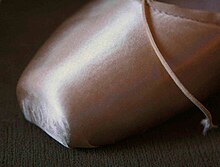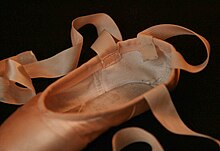Pointe shoe
History of pointe shoes
Women began to dance ballet in 1681, twenty years after King Louis XIV of France ordered the founding of the Académie Royale de Danse. At that time, the standard women's ballet shoe had heels. Mid-18th century dancer Marie Camargo of the Paris Opéra Ballet was the first to wear a non-heeled shoe, enabling her to perform leaps that would have been difficult, if not impossible, in the more conventional shoes of the age. After the French Revolution, heels were completely eliminated from standard ballet shoes. These flat-bottomed predecessors of the modern pointe shoe were secured to the feet by ribbons and incorporated pleats under the toes to enable dancers to leap, execute turns, and fully extend their feet.The first dancers to rise up on their toes did so with the help of an invention by Charles Didelot in 1795. His "flying machine" lifted dancers upward, allowing them to stand on their toes before leaving the ground. This lightness and ethereal quality was well received by audiences and, as a result, choreographers began to look for ways to incorporate more pointework into their pieces.
As dance progressed into the 19th century, the emphasis on technical skill increased, as did the desire to dance en pointe without the aid of wires. When Marie Taglioni first danced La Sylphide en pointe, her shoes were nothing more than modified satin slippers; the soles were made of leather and the sides and toes were darned to help the shoes hold their shapes. Because the shoes of this period offered no support, dancers would pad their toes for comfort and rely on the strength of their feet and ankles for support.
The next substantially different form of pointe shoe appeared in Italy in the late 19th century. Dancers like Pierina Legnani wore shoes with a sturdy, flat platform at the front end of the shoe, rather than the more sharply pointed toe of earlier models. These shoes also included a box—made of layers of fabric—for containing the toes, and a stiffer, stronger sole. They were constructed without nails and the soles were only stiffened at the toes, making them nearly silent.
The birth of the modern pointe shoe is often attributed to the early 20th century Russian ballerina, Anna Pavlova, who was one of the most famous and influential dancers of her time. Pavlova had particularly high, arched insteps, which left her vulnerable to injury when dancing en pointe. She also had slender, tapered feet, resulting in excessive pressure applied to her big toes. To compensate for this, she inserted toughened leather soles into her shoes for extra support and flattened and hardened the toe area to form a box.
Construction
Every dancer has unique feet, with variations that include toe length and shape, arch flexibility, and mechanical strength. Consequently, most pointe shoe manufacturers produce more than one model of shoe, with each model offering a different fit, as well as custom fitted shoes. Regardless of the manufacturer or model, however, all pointe shoes share two important structural features that enable dancers to dance on the tips of their toes:- A box within the front end of the shoe that encases and supports the dancer's toes.
- A shank, which is a piece of rigid material that serves to stiffen the sole so as to provide support for the arch of the en pointe foot.
Box
The box is a hard enclosure within the front end of the shoe that encases and supports the dancer's toes. The front end of the box is flattened so as to form a platform upon which the dancer can balance, and fabric covers the exterior of the box for æsthetics.In conventional pointe shoes, the box is typically made from tightly packed layers of paper and fabric that have been glued together and then shaped into an enclosure. When the glue dries, it becomes hard and provides the required stiffness. In some newer pointe shoes, the box may be made from plastic and rubber, with rigidity provided by the plastic.
Sole
Aesthetic appearance is of paramount importance for modern pointe shoes. To achieve an elegant appearance, the shoe's more decorative outer fabric is prominently featured, covering the maximum possible area of the shoe's visible surfaces. To this end, the sole is made of thin material to give it a minimal profile, and a margin of satin is artfully pleated around it so that the sole covers only part of the bottom of the shoe.
Shank
Dancers will sometimes wear different pointe shoe models for different performance pieces. In such cases, the choreography often dictates the type of shank required; a lyrical style may call for a softer shoe, while an aggressive style with many turns is more easily performed in a hard, stiff shoe.
Ribbons and elastic band
A pointe shoe employs two fabric ribbons and an elastic band to secure it to the foot. Most of the work of securing shoes to feet is done by the ribbons. The two ribbons wrap around the dancer's ankle in opposite directions, overlapping one another so as to form a cross at the front. The ends are then tied together in a knot, which is then tucked under the ribbon on the inside of the ankle to hide it from view. The elastic band—which traverses the front of the ankle below the ribbons—keeps the heel of the shoe in place against the foot when the dancer is en pointe.The locations where the band and ribbons attach to a shoe is critical, as incorrect placement can result in a poorly fitting shoe. Optimal placement depends on the physical attributes of the foot to which it will be mated, and consequently the ribbons and elastic bands cannot be attached during the shoe manufacturing process. After acquiring a new pair of pointe shoes, a dancer must determine the appropriate attachment locations for the ribbons and elastic bands and then sew them, or arrange for them to be sewn, onto the shoes.
Demi-pointe shoe
A demi-pointe shoe, which is also variously called a break-down, pre-pointe, or a soft-block shoe, shares many characteristics with pointe shoes.For example its outer appearance resembles that of a pointe shoe and it has a toe box, although the box is softer and the wings (sides of the toe box) are typically not as deep as those found on pointe shoes. Demi-pointe shoes are secured to the feet with ribbons and elastic band in identical fashion to pointe shoes. Unlike pointe shoes, however, demi-pointe shoes have no shank and, as a result, they do not provide the support necessary for proper pointe work.Demi-pointe shoes are most often used to train dancers who are new to pointe technique. They serve to acclimate dancers to the feel of wearing pointe shoes and to strengthen the ankles and feet in preparation for dancing on pointe in pointe shoes. The toe box allows the dancer to experience the feel of a pointe shoe, while the insole and outsole work together to provide the resistance needed for developing foot and ankle strength.






Tidak ada komentar:
Posting Komentar